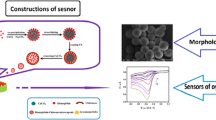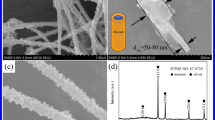Abstract
A nano-sized bionic function interface was prepared by immobilizing red blood cells onto a silver electrode, which was modified with cysteamine and colloidal gold. Scanning electron microscopy and electrochemical impedance spectroscopy were used to characterize its surface. Cyclic voltammograms in phosphate buffer solution of pH 7.0 exhibited a pair of redox peaks for oxygen at -378 and -207 mV, respectively. The reduction peak currents at -378 mV were linearly proportional to the oxygen concentration in the range from 12.6 µM to 1.39 mM. Cyclic voltammetry also indicated that the functional surface enhanced the ability of red blood cells to transport oxygen.







Similar content being viewed by others

References
Ted G-S (2004) The red cell. Medicine 32:1–3
Nick (2007) A Physiology of red and white blood cells. Anaesth Intensive Care Med 8:203–208
Sheng Y, Yuan Y, Liu C, Tao X, Shan X, Xu F (2009) In vitro macrophage uptake and in vivo biodistribution of PLA-PEG nanoparticles loaded with hemoglobin as blood substitutes: effect of PEG content. J Mater Sci, Mater Med 20:1881–1891
Gladwin MT, Crawford JH, Patel RP (2004) The biochemistry of nitric oxide, nitrite, and hemoglobin: role in blood flow regulation. Free Radical Biol Med 36:707–717
Shan X, Chen L, Yuan Y, Liu C, Zhang X, Sheng Y, Xu F (2010) Quantitative analysis of hemoglobin content in polymeric nanoparticles as blood substitutes using Fourier transform infrared spectroscopy. J Mater Sci, Mater Med 21:241–249
Brittain T (2002) Molecular aspects of embryonic hemoglobin function. Mol Aspects Med 23:293342
Kosmachevskaya OV, Topunov AF (2009) Hemoglobins: diversity of structures and functions. Applied Biochem Microbiol 45:563–587
Gou X, Li N, Lian L, Yan D, Zhang H, Wei Z, Wu C (2007) Hypoxic adaptations of hemoglobin in Tibetan chick embryo: high oxygen-affinity mutation and selective expression. Comp Biochem Physiol B Biochem Mol Biol 147:147–155
Koehler RC, Fronticelli C, Bucci E (2008) Insensitivity of cerebral oxygen transport to oxygen affinity of hemoglobin-based oxygen carriers. Biochim Biophys Acta (BBA)—Proteins Proteomics 1784:1387–1394
Sakai H, Sato A, Sobolewski P, Takeoka S, Frangos JA, Kobayashi K, Intaglietta M, Tsuchida E (2008) NO and CO binding profiles of hemoglobin vesicles as artificial oxygen carriers. Biochim Biophys Acta (BBA)—Proteins Proteomics 1784:1441–1447
Xu F, Yuan Y, Shan X, Liu C, Tao X, Sheng Y, Zhou H (2009) Long-circulation of hemoglobin-loaded polymeric nanoparticles as oxygen carriers with modulated surface charges. Int J Pharm 377:199–206
Sakai H, Sou K, Tsuchida E (2009) Chapter 19: hemoglobin-vesicles as an artificial oxygen carrier. Methods Enzymol 465:363–384
Silvester WB, Berg RH, Schwintzer CR, Tjepkema JD (2007) Chapter 5: oxygen responses, hemoglobin, and the structure and function of vesicles. Springer Netherlands. Berlin 6:105–146
Buehler PW, Alayash AI (2008) All hemoglobin-based oxygen carriers are not created equally. Biochim Biophys Acta (BBA)—Proteins Proteomics 1784:1378–1381
Winslow RM (2008) Cell-free oxygen carriers: scientific foundations, clinical development, and new directions. Biochim Biophys Acta (BBA)—Proteins Proteomics 1784:1382–1386
Bucci E (2009) Thermodynamic approach to oxygen delivery in vivo by natural and artificial oxygen carriers. Biophys Chem 142:1–6
Low D, Milne M (2007) Crystalloids, colloids, blood, blood products and blood substitutes. Anaesth Intensive Care Med 8:56–59
Diesen D, Stamler JS (2007) S-Nitrosylation and PEGylation of hemoglobin: toward a blood substitute that recapitulates blood. J Mol Cell Cardiol 42:921–923
Cohn CS, Cushing MM (2009) Oxygen therapeutics: perfluorocarbons and blood substitute safety. Crit Care Clin 25:399–414
Booth C, Highley D (2010) Crystalloids, colloids, blood, blood products and blood substitutes. Anaesth Intensive Care Med 11:50–55
Strengers PFW, Twuijver E (2009) Blood, blood components, plasma, and plasma products. Side Effects of Drugs Annual 31:527–546
Doron A, Katz E, Willner I (1995) Organization of Au colloids as monolayer films onto ITO glass surfaces: application of the metal colloid films as base interfaces to construct redox–active monolayers. Langmuir 11:1313–1317
Gu H-Y, Lu S-Y, Jiang Q-Y, Yu C-M, Li G-X (2006) A novel nitric oxide cellular biosensor based on red blood cells immobilized on gold nanoparticles. Anal Lett 39:2849–2859
Yang Q, Qu Y, Bo Y, Wen Y, Huang S (2010) Biosensor for atrazin based on aligned carbon nanotubes modified with glucose oxidase. Microchim Acta 168:197–203
Wang C, Zhang L, Guo Z, Xu J, Wang H, Zhai K, Xin Z (2010) A novel hydrazine electrochemical sensor based on the high specific surface area grapheme. Microchim Acta 169:1–6
Zhang J, Wang J, Zhu J, Xu J, Chen H, Xu D (2008) An electrochemical impedimetric arrayed immunosensor based on indium tin oxide electrodes and silver-enhanced gold nanoparticles. Microchim Acta 163:63–70
Yu C-M, Guo J-W, Gu H-Y (2009) Direct electrochemical behavior of hemoglobin at surface of Au@Fe3O4 magnetic nanoparticles. Microchim Acta 166:215–220
Gu H-Y, Yu A-M, Chen H-Y (2001) Direct electron transfer and characterization of hemoglobin immobilized on a Au colloid-cysteamine-modified gold electrode. J Electroanal Chem 516:119–126
Gu H-Y, Sa R-X, Yuan S-S, Chen H-Y, Yu A-M (2003) The self-assembly, characterization of hepatocytes on nano-sized gold colloid and construction of cellular biosensor. Chem Lett 2:934–935
Liu Y, Gu H-Y (2008) Amperometric detection of nitrite using a nanometer-sized gold colloid modified pretreated glassy carbon electrode. Microchim Acta 162:101–106
Wang Y-H, Gu H-Y (2009) Hemoglobin co-immobilized with silver-silver oxide nanoparticles on a bare silver electrode for hydrogen peroxide electroanalysis. Microchim Acta 164:41–47
Laviron E (1979) The use of linear potential sweep voltammetry and of A. C. voltammetry for the study of the surface electrochemical reaction of strongly adsorbed systems and of redox modified electrodes. J Electroanal Chem 100:263–270
Laviron E (1979) General expression of the linear potential sweep voltammogram in the case of diffusionless electrochemical systems. J Electronal Chem 101:19–28
Huang K-J, Sun J-Y, Xu C-X, Niu D-J, Xie W-Z (2010) A disposable immunosensor based on gold colloid modified chitosan nanoparticles-entrapped carbon paste electrode. Microchim Acta 168:51–58
Xiong H, Zhao Y, Liu P, Zhang X, Wang S (2010) Electrochemical properties and the determination of nicotine at a multi-walled carbon nanotubes modified glassy carbon electrode. Microchim Acta 168:31–36
Lai G-S, Zhang H-L, Han D-Y (2009) Amperometric hydrogen peroxide biosensor based on the immobilization of horseradish peroxidase by carbon-coated iron nanoparticles in combination with chitosan and cross-linking of glutaraldehyde. Microchim Acta 165:159–165
Shibayama N, Ikeda-Saito M, Hori H, Itaroku K, Morimoto H, Saigo S (1995) Oxygen equilibrium and electron paramagnetic resonance studies on copper(II)-iron(II) hybrid hemoglobins at room temperature. FEBS Lett 372:126–130
Younathan JN, Wood KS, Meyer TJ (1992) Electrocatalytic reduction of nitrite and nitrosyl by iron (III) protoporphyrin IX dimethyl ester immobilized in an electropolymerized film. Inorg Chem 31:3280–3285
Xu Y, Hu C, Hu S (2008) Direct electron-transfer of native hemoglobin in blood: kinetics and catalysis. Bioelectrochemistry 72:135–140
Wang JX, Marinković NS, Adžić RR (1998) Structure of Br adlayers in the course of electrocatalytic reactions 02 reduction on Pt(111) and Au(100). Colloids Surf A 134:165–171
Acknowledgements
This work was financially supported by the National Natural Science Foundation of China (Grant numbers: 20675042; 20875051), the Natural Science Foundation of Jiangsu Province (Grant number: BK2009152).
Author information
Authors and Affiliations
Corresponding author
Rights and permissions
About this article
Cite this article
Wang, YH., Guo, JW. & Gu, HY. A novel nano-sized bionic function interface for enhancing the ability of red blood cells to carry oxygen. Microchim Acta 171, 179–186 (2010). https://doi.org/10.1007/s00604-010-0392-3
Received:
Accepted:
Published:
Issue Date:
DOI: https://doi.org/10.1007/s00604-010-0392-3



